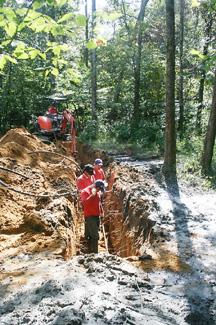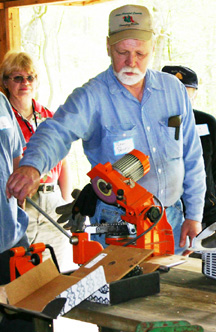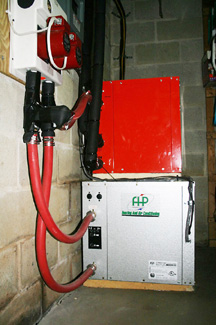
Volume XVII, Issue 38 # September 17 - September 23, 2009 |
 |
Home Improvements
Peter and Helen Perry put the earth’s constant temperature to work
by Allen Delaney
 |
 |
 |
Since 1979, when Peter and Helen Perry moved to Davidsonville, they’ve depended on their 30 acres of Patuxent bottomland to keep them warm. In 30 years, they’ve cut roughly 100 cords of wood — more than enough to fill their three-story house.
Now they’re shifting their source of comfort from the woods around their Russian dacha-style home to the earth beneath it.
“Our 15-year-old central air conditioner had outlived itself. We decided when upgrading, we might as well come into the 21st century and put in a heat pump as well as air conditioning,” Peter Perry told Bay Weekly.
The retired astrophysicist abided by the laws of nature to make the best choice: geothermal.
“Water has a better ability to deal with heat and cold than air,” he explains. “Water is much heavier, so it can absorb much more heat. If you want to cool something off, it’s better to put it in water than to blow on it.”
Sealing the deal, says Helen, was a 30 percent tax savings on the cost of installation via the Energy Improvement and Extension Act of 2008.
Maryland also offers a state rebate of $500 per cooling ton up to a maximum of $3,000.
The Department of Energy and the Environmental Protection Agency have both endorsed ground-source heat pump systems as among the most energy efficient and environmentally friendly heating, cooling and water-heating systems.
Earth and Water
Geothermal uses the earth’s temperature — around 53 degrees in the Mid-Atlantic region — plus water to heat, cool and bring hot water to homes.
Ground temperature is constant, and in summer it’s cooler than the air, so a geothermal system pumps that hot air beneath ground where it is cooled. The resulting cool air is then pumped back into the house. During winter, just the opposite happens: The geothermal heat pump extracts heat from the ground and brings it into the home.
But first, you’ve got to reach deep into the earth.
Late last month, Allied Well Drillers set up shop in the Perrys’ woods. From water wells, the company has expanded to geothermal wells, but the process is much the same. The drillers backed their rig down a narrow path, inching the truck in between trees and hedges, and set up about 180 feet from the house.
As one drill bit lowered, another was attached atop until, bit by bit, the drilling reached down 300 feet through two aquifers, rock and sand. Where they land doesn’t much matter, said Perry. They’re not seeking water, only Earth’s cool depths.
Next the Perrys’ geothermal contractor, Owens Comfort Systems, threaded flexible polyethylene pipes into the deep wells. Then the three U-shaped loops were joined together in trenches dug five feet deep, below the frost line. Trenching the piping to the house made the vital connection.
Home to Earth
The inch-and-a-half pipes entered the Perrys’ basement to attach to two pumps, one to pump the water through the pipes out to the wells, and one to pump, or pull, the water back to the house and into a heat exchanger.
“The pump in our water well is 125 feet down, so repairs were one of the things I worried about,” Perry said.
He worries no more. All the pumps are in the basement, so if they break, they can be fixed above ground.
Next, water and ethanol were injected into the piping loop, to be circulated by the pumps. The Perrys’ system is a closed system, so nothing escapes into the ground water.
From the pumps, conventional technology takes over. A pair of red pipes feed into a system that, Perry says, is like any old air-conditioning or heat pump unit, except that it’s much more efficient.
 |
|
The heating cycle begins when the groundwater is pumped from the polyethylene pipes to a water-to-refrigerant heat exchanger on the geothermal heat pump. The tubes on the refrigerant side of the heat exchanger are filled with a low-temperature liquid, such as Freon. As the liquid refrigerant flows through the heat exchanger, it absorbs heat from the groundwater and evaporates to form a cool gas (10 to 30 degrees cooler than the groundwater). The water from the pipe gives up heat as it flows through the heat exchanger, exiting the home at a cooler temperature to be warmed by the earth as it again travels through the buried piping.
The Perrys also replaced their old hot water system, linking to the new geothermal system. The water in their new tank is heated up to 123 degrees by the heat exchanger.
A prodigious cook who’s writing a cookbook, Helen is delighted. “The water is much hotter,” she says, “so the heater in the dishwasher doesn’t need to come on.”
As geothermal does all this without the outside unit of a conventional climate control system, it’s also quieter and less unsightly.
“What’s missing is the thing that sits outside and makes a lot of noise when you’re having your picnic,” Peter says. “In the house it’s extremely quiet; it just purrs a little.”
A more experienced geothermal user agrees.
“I enjoy hearing the crickets at night while I’m on my porch,” says Larry Rowse of St. Leonard in Calvert County. “I like the fact that I don’t hear a fan and a compressor coming on and off.”
Seven years ago, Rowse purchased a renovated 1825 farmhouse in which the previous owner had installed a geothermal system. “It makes sense to heat and cool an old, drafty 3,100-square-foot home with a geo system. It’s much more economical,” Rowse said. The only maintenance he’s had to perform on the seven-year-old system, other than to change the air filters, was to replace one of the two water pumps.

 The Cost of Comfort
The Cost of Comfort
Geothermal is not a cheap way to heat and cool your home. The Perrys’ system cost $35,000.
Expensive, but not, supposedly, in the long run.
“It’s the only system that will pay for itself within its lifetime,” says Rod Owens, the Perrys’ contractor.
Geothermal is said to save up to half on a home’s heating and cooling.
Sometimes even more. The new James Muldoon River Center at St. Mary’s College was built with geothermal climate control. Compared to the heating and cooling costs of the other buildings on campus, “it’s almost free to heat and cool the building,” says Christopher Bornand, college sustainability coordinator.
Is it working for the Perrys?
“It better!” says Peter, who anticipates higher savings in summer, when, he says, “I was running the air conditioning a lot.”
He’s already delighted by the technology.
“I got a handy-dandy 21st century thermostat with a remote. So I can set the house temperature to whatever I want in four time periods. I set it to give me temperatures I like throughout the day, and I forget it.”
But he’ll still be cutting firewood. In winter, Helen cooks on the wood stove, and they like the cozy warmth wood gives them.
